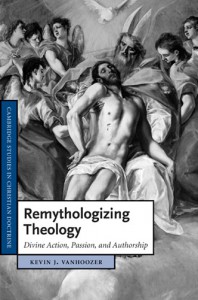 Kevin Vanhoozer has developed a reputation for reflecting deeply and at length on theological and hermeneutical prolegomena; perhaps too much at length. In the Preface to Remythologizing Theology, he admits that he has been “as guilty as anyone of procrastinating in the prolegomenal fields,” but with this text he has succeeded in moving on from preparatory methodology to the thing itself, theology proper, the doctrine of God.
Kevin Vanhoozer has developed a reputation for reflecting deeply and at length on theological and hermeneutical prolegomena; perhaps too much at length. In the Preface to Remythologizing Theology, he admits that he has been “as guilty as anyone of procrastinating in the prolegomenal fields,” but with this text he has succeeded in moving on from preparatory methodology to the thing itself, theology proper, the doctrine of God.
In other words, Vanhoozer has moved on from method to matter with this book, and the matter is the doctrine of God. Not only is the matter the doctrine of God, but it turns out that there is something the matter with the doctrine of God, and Vanhoozer writes to interrupt the flow of recent conversations. That deliberate interruption, or intervention, or interception of recent trends in the doctrine of God, is the main thing this big book accomplishes. More on that in a later post.
But first, let us admit that while it is good to get past prolegomena, there’s no reason to rush away from methodology. Some sort of commitments about theological method are always at work underneath any presentation of doctrine, and it’s better to be methodologically self-aware than methodologically oblivious. A great many pages of Remythologizing are still devoted to methodology in a certain sense, and to defining what sort of theology this remythologizing is.
Vanhoozer’s style here is to do something doctrinal and then to reflect on the meaning and reason and method of what he has done. He remains evangelical theology’s greatest abstracter, conversationalist, and critic (if by “critic” we mean something more like a music critic or art critic than a biblical critic). He almost never operates at the “four views” level, simply surveying available options. That pedagogically useful method has a deadening effect on constructive doctrine. Vanhoozer’s approach is to try something, redescribe it, abstract the principles from it, conceptually elaborate those, and then reapply them to the subject matter for further applications.
Here in his theology of the God who communicates, for example, he describes his method in terms of listening to voices:
The primary voice I strain to hear is that of the triune God, discerned above all through the self-attestation of the living Word in the polyphonic Scriptures, aided and abetted by the antiphonal ecclesial choirs from East and West, as well as the occasional theological soloist. (xvii)
There is in that sentence a wonderful and well-ordered approach to theology: God, Scripture, the church, other theologians. Simply spell out the How To for each of those aspects of the theological process, and you’ve got a method. And of course the quick reference to the Scriptures as polyphonic indicates that there is plenty of hermeneutical reflection going on in this book. I don’t think we should ever expect Vanhoozer to stop honing his hermeneutics, even as he keeps developing his doctrines.
But for all the ongoing interest in methodology, Vanhoozer’s Remythologizing takes the step forward to doctrine proper, and his primary doctrine is that God communicates. It is no merely methodological point that God communicates; it puts us squarely into “first theology,” “that coordinated construal of God, Scripture, and hermeneutics that distinguishes one theological approach from another” (13-14). In this book, the emphasis falls on the doctrine of God, and if it is not a complete doctrine of God, at least it is “an essay in aid of the development of the doctrine of God.” Vanhoozer hasn’t just picked a pet topic or two from among the many possible things he might have focused on. No, in this first major turn to the subject matter of theology proper, he goes for the biggest, most important, central point of contention in modern theology.
More to come.